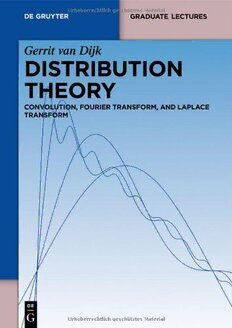
Distribution theory: Convolution, Fourier transform, and Laplace transform PDF
Preview Distribution theory: Convolution, Fourier transform, and Laplace transform
GerritvanDijk DistributionTheory DeGruyterGraduateLectures Gerrit van Dijk Distribution Theory Convolution, Fourier Transform, and Laplace Transform MathematicsSubjectClassification2010 35D30,42A85,42B37,46A04,46F05,46F10,46F12 Author Prof.Dr.GerritvanDijk UniversiteitLeiden MathematischInstituut NielsBohrweg1 2333CALeiden TheNetherlands E-Mail:[email protected] ISBN978-3-11-029591-7 e-ISBN978-3-11-029851-2 LibraryofCongressCataloging-in-PublicationData ACIPcatalogrecordforthisbookhasbeenappliedforattheLibraryofCongress. BibliographicinformationpublishedbytheDeutscheNationalbibliothek TheDeutscheNationalbibliothekliststhispublicationintheDeutscheNationalbibliografie;detailed bibliographicdataareavailableintheInternetathttp://dnb.dnb.de. ©2013WalterdeGruyterGmbH,Berlin/Boston Coverimage:Fourier-Transformationofasawtoothwave.©TieR0815 Typesetting:le-texpublishingservicesGmbH,Leipzig Printingandbinding:Hubert&Co.GmbH&Co.KG,Göttingen Printedonacid-freepaper PrintedinGermany www.degruyter.com Preface Themathematicalconceptofadistributionoriginatesfromphysics. Itwasfirstused byO. Heaviside, aBritishengineer, inhistheory of symboliccalculusand then by P.A.M. Dirac around 1920 in his research on quantum mechanics, in which he in- troduced the delta-function (or delta-distribution). The foundations of the mathe- maticaltheoryofdistributionswerelaidbyS.L.Sobolevin1936,whileinthe1950s L.Schwartzgaveasystematicaccountofthetheory. Thetheoryofdistributionshas numerousapplicationsandisextensivelyusedinmathematics,physicsandengineer- ing. Intheearlystagesofthetheoryoneusedthetermgeneralizedfunctionrather thandistribution,asisstillreflectedinthetermdelta-functionandthetitleofsome textbooksonthesubject. Thisbookisintendedasanintroductiontodistributiontheory,asdevelopedby LaurentSchwartz. Itisaimedatanaudienceofadvancedundergraduatesorbegin- ning graduate students. It is based on lectures I have given at Utrecht and Leiden University. Student inputhas strongly influenced the writing, and I hope that this bookwillhelpstudentstosharemyenthusiasmforthebeautifultopicsdiscussed. Starting with the elementary theory of distributions, I proceed to convolution products of distributions, Fourier and Laplace transforms, tempered distributions, summabledistributionsandapplications. Thetheoryisillustratedbyseveralexam- ples,mostlybeginningwiththecaseofthereallineandthenfollowedbyexamples inhigherdimensions. Thisisajustifiedandpracticalapproachinourview,ithelps thereadertobecomefamiliarwiththesubject. Amoderatenumberofexercisesare addedwithhintstotheirsolutions. Thereisrelativelylittleexpositoryliteratureondistributiontheorycomparedto othertopicsinmathematics,butthereisastandardreference[10],andalso[6].Ihave mainlydrawnon[9]and[5]. Themainprerequisitesforthebookareelementaryreal,complexandfunctional analysisandLebesgueintegration. Inthelaterchaptersweshallassumefamiliarity withsomemoreadvancedmeasuretheoryandfunctionalanalysis,inparticularwith the Banach–Steinhaus theorem. The emphasis is however on applications, rather thanonthetheory. For terminology and notations we generally follow N. Bourbaki. Sections with astarmaybeomitted atfirstreading. Theindexwillbehelpfulto traceimportant notionsdefinedinthetext. Thanksaredue to mycolleagues and students inThe Netherlands for their re- marksandsuggestions. SpecialthanksareduetoDrJ.D.Stegeman(Utrecht)whose helpindevelopingthefinalversionofthemanuscripthasgreatlyimprovedthepre- sentation. Leiden,November2012 GerritvanDijk Contents Preface V 1 Introduction 1 2 DefinitionandFirstPropertiesofDistributions 3 2.1 TestFunctions 3 2.2 Distributions 4 2.3 SupportofaDistribution 6 3 DifferentiatingDistributions 9 3.1 DefinitionandProperties 9 3.2 Examples 10 3.3 TheDistributionsx+λ−1(λ(cid:2)=0,−1,−2,...)* 12 3.4 Exercises 14 3.5 Green’sFormulaandHarmonicFunctions 14 3.6 Exercises 20 4 MultiplicationandConvergenceofDistributions 22 4.1 MultiplicationwithaC∞Function 22 4.2 Exercises 23 4.3 ConvergenceinD(cid:4) 23 4.4 Exercises 24 5 DistributionswithCompactSupport 26 5.1 DefinitionandProperties 26 5.2 DistributionsSupportedattheOrigin 27 5.3 Taylor’sFormulaforRn 27 5.4 StructureofaDistribution* 28 6 ConvolutionofDistributions 31 6.1 TensorProductofDistributions 31 6.2 ConvolutionProductofDistributions 33 6.3 AssociativityoftheConvolutionProduct 39 6.4 Exercises 39 6.5 NewtonPotentialsandHarmonicFunctions 40 6.6 ConvolutionEquations 42 6.7 SymbolicCalculusofHeaviside 45 6.8 VolterraIntegralEquationsoftheSecondKind 47 VIII Contents 6.9 Exercises 49 6.10 SystemsofConvolutionEquations* 50 6.11 Exercises 51 7 TheFourierTransform 52 7.1 FourierTransformofaFunctiononR 52 7.2 TheInversionTheorem 54 7.3 Plancherel’sTheorem 56 7.4 DifferentiabilityProperties 57 7.5 TheSchwartzSpaceS(R) 58 7.6 TheSpaceofTemperedDistributionsS(cid:4)(R) 60 7.7 StructureofaTemperedDistribution* 61 7.8 FourierTransformofaTemperedDistribution 63 7.9 Paley–WienerTheoremsonR* 65 7.10 Exercises 68 7.11 FourierTransforminRn 69 7.12 TheHeatorDiffusionEquationinOneDimension 71 8 TheLaplaceTransform 74 8.1 LaplaceTransformofaFunction 74 8.2 LaplaceTransformofaDistribution 75 8.3 LaplaceTransformandConvolution 76 8.4 InversionFormulafortheLaplaceTransform 79 9 SummableDistributions* 82 9.1 DefinitionandMainProperties 82 9.2 TheIteratedPoissonEquation 83 9.3 ProofoftheMainTheorem 84 9.4 CanonicalExtensionofaSummableDistribution 85 9.5 RankofaDistribution 87 10 Appendix 90 10.1 TheBanach–SteinhausTheorem 90 10.2 TheBetaandGammaFunction 97 11 HintstotheExercises 102 References 107 Index 109 1 Introduction Differentialequationsappearinseveralforms. Onehasordinarydifferentialequa- tionsandpartialdifferentialequations,equationswithconstantcoefficientsandwith variablecoefficients. Equationswithconstantcoefficientsarerelativelywellunder- stood.Ifthecoefficientsarevariable,muchlessisknown.Letusconsiderthesingular differentialequationofthefirstorder xu(cid:4) =0. (∗) Thoughtheequationisdefinedeverywhereontherealline,classicallyasolutionis onlygivenforx >0andx <0. Inbothcasesu(x)=cwithcaconstant,different forx>0andx<0eventually.Inordertofindaglobalsolution,weconsideraweak formofthedifferentialequation. LetϕbeaC1functionontherealline,vanishing outsidesomeboundedinterval.Thenequation(∗)canberephrasedas (cid:4)∞ (cid:2) (cid:3) xu(cid:4), ϕ = xu(cid:4)(x)ϕ(x)dx=0. −∞ Applyingpartialintegration,weget (cid:2) (cid:3) (cid:2) (cid:3) xu(cid:4), ϕ =− u,ϕ+xϕ(cid:4) =0. Takeu(x)=1forx≥0,u(x)=0forx<0.Thenweobtain (cid:4)∞ (cid:4)∞ (cid:4)∞ (cid:2) (cid:3) (cid:5) (cid:6) xu(cid:4), ϕ =− ϕ(x)+xϕ(cid:4)(x) dx=− ϕ(x)dx+ ϕ(x)dx =0. 0 0 0 Call this function H, known as the Heaviside function. We see that we obtain the following(weak)globalsolutionsoftheequation: u(x)=c H(x)+c , 1 2 withc andc constants.Observethatwegetatwo-dimensionalsolutionspace.One 1 2 canshowthattheseareallweaksolutionsoftheequation. Thefunctionsϕarecalledtestfunctions. Ofcourseonecannarrowtheclassof testfunctionstoCkfunctionswithk>1,vanishingoutsideaboundedinterval.This iscertainlyusefuliftheorderofthedifferentialequationisgreaterthanone.Itwould beniceifwecouldassumethatthetestfunctionsareC∞functions,vanishingoutside abounded interval. Butthenthereisreally something toshow: dosuchfunctions exist? The answer is yes (see Chapter 2). Therefore we canset upa nice theory of globalsolutions. Thisisimportantinseveralbranchesofmathematicsandphysics. Consider,forexample,apointmassinR3withforcefieldhavingpotentialV =1/r,
